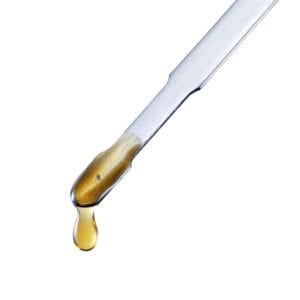
Lubrication Glossary
An additive is a substance that is added to a base oil in order to change its properties or enhance its performance.
An anti-foam additive is a type of lubricant additive that prevents the formation of foam in petroleum-based products by reducing the amount of surface and internal bubbles. These additives typically use either silicone or polymers to achieve this goal. This allowing petroleum products to flow more effectively and with less disruption. Anti-foam additives are especially useful for applications involving extreme pressure conditions. They help reduce the risk of sliding surfaces seizing up.
An anti-wear additive is a specialized chemical compound that is added to a lubricant with the goal of reducing wear in high-load contact points. The additive sticks onto metal components and creates a thin protective layer between them, preventing direct metal-to-metal contact and thus reducing friction. This can dramatically extend the lifespan of components and reduce maintenance costs.
Ash is a byproduct of combustion that forms on the engine's parts like the combustion chamber when heated to high temperatures. It can also be an additive in lubricants which helps to prevent seizing of the sliding surfaces under extreme pressure conditions.
Base oil is a fundamental component of lubricants. It is used in the production of motor oils, greases, and other functional fluids. It is commonly derived from crude oil fractional distillation or synthetic methods and then blended with various additives to form a final lubricant.
Catalytic converters are devices used in the exhaust systems of motor vehicles in order to reduce emissions. They convert harmful pollutants in the exhaust gas into less hazardous substances, such as carbon dioxide, nitrogen and water vapor. Oxidizing catalytic converters break down hydrocarbons such as gasoline and diesel fuel, while reducing catalytic converters reduce nitrous oxide emissions from the engine. All catalytic converters contain noble metals like platinum, palladium or rhodium; however, they can be damaged if lead or phosphorus-containing fuels and lubricants are used in the engine.
A corrosion inhibitor is an additive used in lubricants to help protect metal parts that are exposed to corrosion. Corrosion occurs when water or other contaminants chemically attack the metals, causing them to corrode and break down. The corrosion inhibitors form a coating on the metals, preventing the contaminants from reaching and attacking the metal parts.
Detergent additives are commonly added to fuel and lubricants in order to keep the engine clean. Common detergent additives include metallic soaps, which have acidic neutralizing capabilities that can help reduce corrosion and build-up caused by the acids created during engine usage. These additives help prolong the life of both your engine and its lubricants, making them an important component of your motor oil maintenance regimen.
Dispersant additive is a chemical compound used in motor oils and other lubricants to aid in keeping particles suspended and prevent the build-up of sludge and varnish. This non-metallic, ashless compound works together with detergent additives to keep solids in suspension and prevent them from settling on engine parts and causing damage.
A Diesel Particulate Filter, or DPF for short, works by trapping and reducing the solid particle content of diesel-fueled vehicle exhaust. The filter is made up of a specially designed ceramic material which traps particles as they enter the system, providing more effective emissions control.
EGR, an acronym for Exhaust Gas Recirculation, is a system designed to reduce the creation of Nitrogen Oxide (NOx) emissions. It accomplishes this by re-circulating exhaust gases back into the vehicle's intake manifold, thereby diluting the fuel/air mixture and lowering the combustion temperature – which helps prevent NOx from forming.
EP Additive is a lubricant enhancer that helps to prevent metal-on-metal contact between two sliding surfaces, even under extreme pressure conditions. This additive ensures that the surfaces are properly lubricated and safely move against each other without sticking or seizing.
The flash point of a petroleum-based product is the minimum temperature at which it will ignite and cause an instantaneous combustion. It is an important factor when assessing the fire and explosion risk of the material. To accurately determine the flash point, special instruments must be used, such as a Pensky-Martens Closed Cup tester.
Friction is a type of force that acts between two objects when they are in contact and moving against each other. It is caused by the interaction between molecules in the two materials, or by their roughness. The amount of friction depends on how hard the two surfaces are pressed together, as well as how smooth and textured they are.
HTHS (High Temperature High Shear) Viscosity is a measure of the resistance that a fluid must flow at high temperatures and under intense shear stress. This viscosity represents the no-load conditions found in highly loaded journal bearings in internal combustion engines, typically at a shear rate of 1 million per second with temperature at 150°C. Lubricant additives are used to help prevent seizing of sliding surfaces under extreme pressure conditions.
Hydrofinishing is a process used in the oil and gas industry to add stability to crude oil. It uses hydrogen treatment to saturate the molecules, making them more resistant to breakdown. As an added benefit, hydrofinishing also helps create lubricants with improved properties which can prevent seizing of surfaces under extreme pressure conditions.
Kinematic viscosity refers to the resistance of a fluid to flow under the influence of gravity. It is usually measured at either 40°C or 100°C and indicates how easily the fluid will move through a system.
Lubrication refers to the use of a lubricant, such as liquid, solid or plastic, to reduce friction and wear. By creating a layer between two surfaces that are moving against each other, a lubricant can decrease the amount of heat and wear generated by the motion and reduce friction. This leads to improved energy efficiency, longer durability of parts, less damage due to impact and shock loads and greater performance of mechanical components.
Multigrade oil is a lubricant that can adapt to a range of temperatures. It meets the requirements for multiple SAE viscosity grades, which means it can be used in more varied conditions than just one oil alone. This makes it more versatile and suitable for different engines, gear systems, and machines.
Oil sludge is a thick, dark residue that builds up over time on the internal components of an engine due to insoluble contaminants in the oil. It has a mayonnaise-like consistency and can drastically reduce the performance of an engine if not removed.
Oxidation is a chemical process whereby petroleum products are broken down, or oxidized, when exposed to oxygen. This reaction can be accelerated by factors such as heat, light, metals, water, acidity or even the introduction of solid contaminants.
Oxidation stability is an important characteristic of petroleum products that measures their resistance to oxidation - a chemical reaction which involves the addition of oxygen atoms to molecules, resulting in deterioration and potentially causing products to break down over time. This measure of oxidation stability indicates how long a product can last in storage or be used for its intended purpose.
The pour point of a fluid is the lowest temperature at which it will still flow. It is an indication of the fluidity of an oil or fuel at low temperatures and can be an important factor when selecting appropriate products for specific applications.
Pre-ignition is an undesirable phenomenon in internal combustion engines, where the fuel/air mixture within the cylinder combusts before the spark plug ignites. This can occur due to buildup of hot gases or lubricants in the chamber, decreasing engine power and potentially causing damage.
Pumpability refers to the ability of oil to remain fluid and pumpable at low temperatures. This property determines how well oil flows through the pump and into its destination, even in cold weather conditions.
Petroleum refining is the process of converting crude oil into more useful products, such as gasoline, diesel and lubricants. This involves going through steps such as thermal cracking, catalytic cracking, polymerization, alkylation, reforming, hydrocracking, hydroforming, hydrogenation and hydrogen treating. Furthermore, additional refining processes include solvent extraction, dewaxing, de-oiling, acid treating and clay filtration. Lubricant additives are often added during the refining process to ensure that sliding surfaces remain functional and free of seizing under extreme pressure conditions.
An automotive problem known as ring sticking occurs when the piston rings, which are narrow metal bands that seal the gap between the piston and cylinder wall, become stuck in their grooves due to excessive contamination. This issue can lead to a decrease in engine performance or even complete failure of an engine.
Synthetic lubricant is a manufactured product specifically formulated to offer superior performance and protection compared to mineral-based lubricants. It is created through the combination of various chemical substances to obtain a desired property profile, such as better viscosity at higher temperatures. Synthetic lubricants provide reliable protection against wear and tear, corrosion, oxidation, and other external factors for improved durability.
Total Acid Number (TAN) is a measure of the amount of KOH (potassium hydroxide) required to neutralize the acidity of petroleum products. TAN is an important indicator of the quality and usability of petroleum fuels and oils, as higher TAN indicates a greater presence of corrosive and acidic compounds.
Total Base Number (TBN) is a chemical measurement used to indicate the total acid-neutralizing capacity of a lubricant. It is expressed as the number of milligrams of Potassium Hydroxide (KOH) that is needed to neutralize the base compounds in one gram of oil. High TBN means more alkaline reserve and greater protection against oil degradation.
Tribology is a scientific field that studies the fundamentals of friction, lubrication and wear between surfaces in contact. It involves the study of interactions between macroscopic elements such as wheels, gears and bearings, as well as how different materials react when in contact with each other. Research in tribology can help engineers develop more efficient machines by understanding how different materials interact with each other under varying conditions.
Varnish is an insoluble and non-wipeable coating that accumulates on internal engine components. If left unchecked, it can build up to a point where the sticking and clogging of parts can result in the breakdown of the engine's inner workings.
Viscosity is a measure of how difficult it is for a fluid to flow. It is defined as the internal friction within the fluid that keeps it from flowing freely, like when honey or syrup flows more slowly than water. Viscosity can vary greatly depending on factors like temperature and pressure, making it an important property to consider in many engineering projects.
Viscosity Index (VI) is a measure used to determine how viscosity of a liquid changes in response to temperature variations. A higher VI indicates that the fluid’s viscosity remains more consistent over a given temperature range, while a lower VI indicates that the fluid’s viscosity will fluctuate significantly for each increase or decrease in temperature.
A viscosity modifier is an additive that helps a lubricating oil maintain its viscosity over a wide range of temperatures. It works by forming protective polymers that help prevent the oil from becoming too thick or thin in extreme temperature fluctuations. This type of additive is beneficial for internal combustion engines which typically require lubricants with specific viscosity characteristics to function properly.
Vyscocity is a comprehensive online resource for anyone looking to learn more about synthetic lubricants. Our easy-to-follow guides, informative articles and helpful videos make it simple to understand the basics of synthetic lubricants.This gives you the tools to make an informed decision when shopping or making repairs. With Vyscocity, you can find the answer to all your synthetic lubricant questions!


